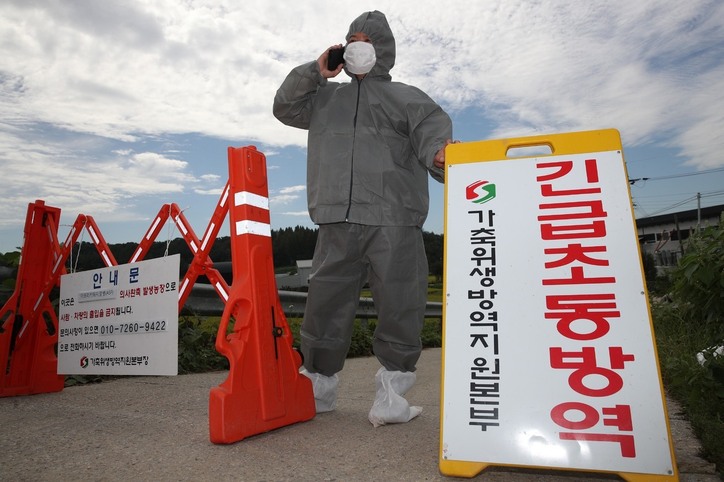 |
|
Quarantine authorities section off a farm in Paju, Gyeonggi Province, where a case of African swine fever (ASF) has broken out, on Sept. 17. (Kim Bong-gyu, staff photographer)
|
No vaccine has been developed for ASF
The frightening thing about African swine fever (ASF) is the risk of contagion. No vaccine has been developed, and with a fatality rate of nearly 100%, preventing its spread is an urgent priority – yet the images of its spread within Asia since last year have been chilling. Some experts are predicting a “virus storm” on the horizon. After first emerging in Kenya during the early 20th century, ASF remained confined to the area until 2007, when it occurred in Georgia before spreading to Russia and other neighboring countries. The first case in Asia occurred in August of last year in China’s Liaoning Province. The sense of alarm grew as the virus spread rapidly throughout Asia (159 cases reported to date, including Hong Kong), spreading as far as 2,000km within the space of a month. During this period, over 100 million pigs died or were culled in China, causing pork prices to rise by 47% from the year before (as of August). The year 2019 has brought a full-scale spread to China’s neighbors: Mongolia in January (11 cases), Vietnam in February (6,083), Cambodia in April (13), North Korea in May (one), Laos in June (94), and Myanmar in August (three); September saw it spread to the Philippines (seven cases) and South Korea (two). The only “clean” regions remaining in Asia are Japan and Taiwan. Explaining the large differences in case numbers between countries, an expert said, “It’s difficult to trust the figures, since the OIE (World Organisation for Animal health) reports are just recommendations and [countries] try to avoid additional reporting after their initial report to receive international cooperation or support.” To halt the spread, establishing the cause and confirming its transmission pathways are of paramount importance. The South Korean government has regarded transmission through wild boars as being unlikely. On Sept. 18, the Ministry of Environment declared that the “likelihood of transmission through boars was deemed to be low,” noting that the Paju farm where cases occurred is located on a plain neighboring Unjeong New City, that the surrounding hilly areas where boars might live have been split into small units, and that no village residents have reported witnessing any boar activity. As additional bases for its conclusion, the ministry said the farm in question is also more than 10km away from the confluence of the Han and Imjin Rivers, and that there were only two reported instances worldwide of ASF being transmitted to livestock pigs through wild boars (both of them at Russian pasture farms). Another possibility is that unheated processed pork products from ASF countries were provided to the farm’s pigs through the facility’s staff. Highly resistant and transmissible, the ASF virus can be killed through heating at 80℃ for 30 minutes or more, but retains infectivity for 1,000 days or more in frozen meat, 300 days or more in dried meat, and 5 weeks or more even in rotted blood. It can also remain present for a month or longer in pens used by infected swine, and may be transmitted quickly on the surface of livestock facilities, vehicles, tools, feed, and people who have been in contact with the animals. Even in cases where farm employees have not directly visited a country where ASF has occurred, the virus may have been transmitted to them through interactions with others who have. From the course of the virus’s spread from China, some are suggesting ASF may have already spread throughout North Korea. “North Korea has a shortage of sterilization agents and quicklime. Once the animal health authorities have made their judgment, they just bury [the pigs] in the ground as is,” said Korean Veterinary Medical Association Vice President Kim Joon-young, who is familiar with the situation of North Korean pig farms, in a Sept. 18 telephone interview with the Hankyoreh. “If people have dug up the bodies of the buried pigs to distribute the meat, or if [the virus] has been spread to the surrounding area by hawks, eagles, and other birds of prey pecking at them, the virus could have already spread throughout North Korea,” he added, suggesting that the virus has been spreading from its origins in China through the border region in North Korea’s Chagang Province and on to the rest of the Korean Peninsula. “There has been talk about a ‘virus storm’ descending on Asia,” Kim also said. By Park Ki-yong, staff reporter Please direct comments or questions to [english@hani.co.kr]






